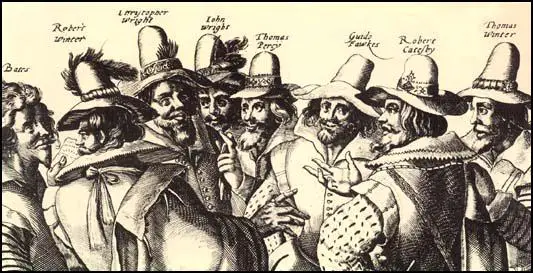Robert Catesby
Robert Catesby, the son of Sir William Catesby, was born in Lapworth, Warwickshire, in 1573. Catesby was educated at Oxford University but as a Roman Catholic left before taking his degree in order to avoid taking the Oath of Supremacy.
In 1596 Elizabeth I became ill. As a precautionary measure, a group of leading Roman Catholics, including Catesby, John Wright, Christopher Wright and Francis Tresham, was arrested and sent to the Tower of London.
In 1601 Catesby was involved with Robert Devereux, Earl of Essex, in the failed attempt to remove Elizabeth I from power. Due to the minor role he played in the rebellion he was not executed and instead was heavily fined. In order to pay the fine Catesby had to sell his manor house at Chastleton.
When Elizabeth I died in 1603 without children, Mary's son, was next in line to the throne. As James was a Protestant, Parliament was also in favour of him becoming king. The Roman Catholics in England were upset that there was going to be another Protestant monarch. They also became very angry when James passed a law that imposed heavy fines on people who did not attend Protestant church services.
In May 1604, Catesby devised the Gunpowder Plot, a scheme to kill James and as many Members of Parliament as possible. At a meeting at the Duck and Drake Inn Catesby explained his plan to Guy Fawkes, Thomas Percy, John Wright and Thomas Wintour. All the men agreed under oath to join the conspiracy. Over the next few months Francis Tresham, Everard Digby, Robert Wintour, Thomas Bates and Christopher Wright also agreed to take part in the overthrow of the king.

After the death of James in the explosion, Catesby planned to make the king's young daughter, Elizabeth, queen. In time, Catesby hoped to arrange Elizabeth's marriage to a Catholic nobleman. It was Everard Digby's task to kidnap Princess Elizabeth from Coombe Abbey.
Catesby's plan involved blowing up the Houses of Parliament on 5th November. This date was chosen because the king was due to open Parliament on that day. At first the group tried to tunnel under Parliament. This plan changed when Thomas Percy was able to hire a cellar under the House of Lords. The plotters then filled the cellar with barrels of gunpowder. Guy Fawkes, because of his munitions experience in the Netherlands, was given the task of creating the explosion.
One of the people involved in the plot was Francis Tresham. He was worried that the explosion would kill his friend and brother-in-law, Lord Monteagle. Tresham therefore sent Lord Monteagle a letter warning him not to attend Parliament on 5 November.
Lord Monteagle became suspicious and passed the letter to Robert Cecil, the king's chief minister. Cecil quickly organised a thorough search of the Houses of Parliament. While searching the cellars below the House of Lords they found the gunpowder and Guy Fawkes. He was tortured and he eventually gave the names of his fellow conspirators.
The conspirators left London and agreed to meet at Holbeche House in Staffordshire. News of their hiding place reached the Sheriff of Worcester and on 8th November the house was surrounded by troops. Catesby and his men refused to surrender and gunfire broke out. Over the next few minutes Catesby, Thomas Percy, Christopher Wright and John Wright were killed.
